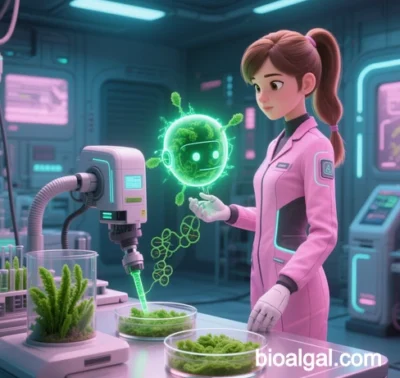
Latest Advances in Algal Biotechnology: Innovations and Applications (2025 Update)
Algal biotechnology has evolved from foundational research to industrial-scale applications, spanning energy, agriculture, medicine, and environmental sustainability. Below is a systematic analysis of core breakthroughs, real-world implementations, challenges, and future trends.
I. Core Technological Breakthroughs
1. Synthetic Biology-Driven Engineering
- Gene Editing: CRISPR-Cas9 and base-editing technologies enable precise metabolic pathway regulation in microalgae (e.g., Chlamydomonas, Phaeodactylum). Lipid productivity now exceeds 1.2 g/L/day, a fivefold increase over wild strains.
- Photosynthetic Efficiency: Engineered PSII supercomplex structures achieve 15% light-to-biomass efficiency, doubling natural rates.
- Heterologous Pathways: Cyanobacteria now produce biodegradable plastics (PHA) directly from CO₂, reducing costs by 30% compared to petrochemical methods.
2. Intelligent Cultivation Systems
- Photobioreactor (PBR) Innovations:
- Vertical stacked airlift PBRs with dynamic LED lighting achieve 90% light utilization and 60% energy savings.
- Offshore floating PBRs (e.g., Japan’s “Algae Ranch”) leverage ocean currents and sunlight to produce 12,000 tons/year of algal oil for aviation biofuels.
- AI Process Control: Machine learning optimizes temperature, pH, and nutrient flows, shortening cultivation cycles by 20% and contamination rates to below 0.5%.
3. High-Value Product Development
- Functional Compounds:
- β-Glucans: Stress-induced cultivation (high salinity, nitrogen deprivation) yields 95% pure β-glucans for immunomodulatory drugs.
- Astaxanthin: Engineered Haematococcus pluvialis strains produce astaxanthin at 8% dry weight, halving traditional extraction costs.
- Vaccine Carriers: Chlamydomonas-expressed HPV virus-like particles (VLPs) induce tenfold higher mucosal IgA antibodies in preclinical trials.
II. Industrial Applications
1. Sustainable Energy Production
- Aviation Biofuels: United Airlines and Viridos produce algae-based SAF with 70% lower CO₂ intensity, targeting 100 million gallons/year by 2024.
- Hydrogen Generation: Green algae (e.g., Chlamydomonas) achieve 12% solar-to-hydrogen efficiency, with continuous 120-day production demonstrated in Germany.
2. Agriculture and Soil Remediation
- Biofertilizers: India’s Tata Group uses nitrogen-fixing cyanobacteria (e.g., Anabaena) to cut urea use by 40% and boost rice yields by 15%.
- Heavy Metal Remediation: Engineered Chlorella strains adsorb cadmium/lead ions, reducing soil cleanup timelines from years to months.
- Aquaculture Integration: Southeast Asia’s algae-fish symbiosis systems recycle 85% of nitrogen/phosphorus, lowering farming costs by 25%.
3. Environmental Solutions
- Wastewater Treatment: China’s OriginWater treats industrial effluents with algal-bacterial membranes, achieving 95% COD removal while producing biodiesel feedstocks.
- Carbon Capture: Denmark’s NovoNutrients converts steel mill emissions into 50,000 tons/year of algal protein, offsetting emissions equivalent to 35,000 hectares of forest.
- Plastic Degradation: UCSD’s algal-bacterial consortia break down PET into PHA at 1 kg/m³/day.
III. Challenges and Future Directions
1. Technical and Economic Barriers
- Cost Reduction: Algae-based biodiesel remains costlier than fossil fuels. Innovations in harvesting (e.g., magnetic separation) and metabolic engineering aim to slash costs by 30%.
- Biosafety: CRISPR-edited algae require fail-safe mechanisms (e.g., kill switches) to prevent ecological risks.
2. Emerging Frontiers
- Space Biology: NASA’s algae modules on the ISS provide CO₂/O₂ cycling and astronaut nutrition with 98% operational stability.
- Synthetic Ecosystems: Dutch “algae-insect-plant” systems convert algal biomass into insect protein and fertilizer, achieving 92% resource efficiency.
3. Policy and Industry Synergy
- Carbon Credits: EU plans to integrate algal carbon sequestration into ETS, offering €60/ton subsidies to spur investment.
- Global Standards: The International Algae Biotechnology Association (IABA) is drafting safety guidelines for engineered algae, set for 2026 implementation.
IV. Case Studies in China
| Project | Innovation | Impact |
|---|---|---|
| Qingdao Marine Microalgae Park | World’s largest closed PBR system (1.2M L) | Produces 500 tons/year of DHA oil (25% global share) |
| Inner Mongolia Desert Algae | Sand-fixing cyanobacteria + solar panels | Captures 20,000 tons CO₂/year, reverses desertification by 40% |
| Pearl River Estuary Remediation | Algae-bivalve symbiosis | Reduces nitrogen/phosphorus by 70%, triples oyster yields |
Conclusion
Algal biotechnology is transitioning from single-product development to integrated, carbon-negative ecosystems. Over the next five years, synergies between synthetic biology, AI, and materials science will position algae as a cornerstone of global decarbonization. As MIT researchers note: “Algae are Earth’s most efficient solar biofactories—their technological maturity will determine whether humanity meets mid-century climate goals.”
Data sourced from publicly available references. For collaborations or domain inquiries, contact: chuanchuan810@gmail.com.






在生物学领域,”bio algal”通常指与藻类相关的生物技术或生物过程。具体可理解为:
词源构成
“bio”:前缀表示”生物的”或”生命相关”,源自biology(生物学)
“algal”:形容词形式,意为”藻类的”,对应algae(藻类)
专业应用场景
微藻代谢调控研究(如脂质合成生物学领域)
藻类生物制品开发(如生物燃料、食品添加剂等)
描述藻类在生态系统中的生物学功能